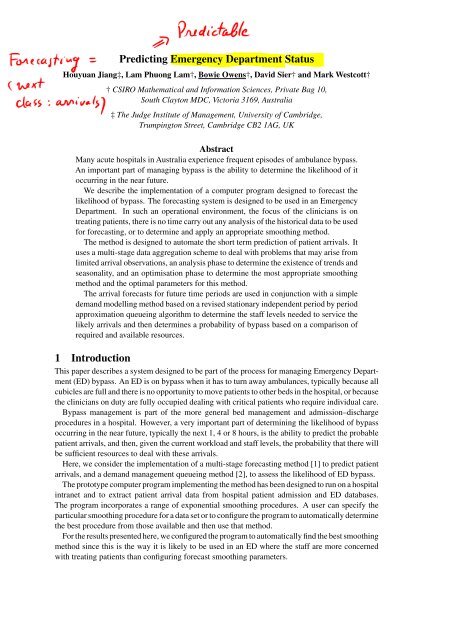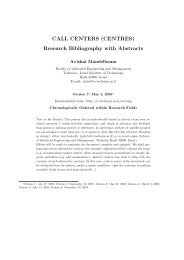PDF-6.4MB - Faculty of Industrial Engineering and Management
PDF-6.4MB - Faculty of Industrial Engineering and Management
PDF-6.4MB - Faculty of Industrial Engineering and Management
You also want an ePaper? Increase the reach of your titles
YUMPU automatically turns print PDFs into web optimized ePapers that Google loves.
Predicting Emergency Department Status<br />
Houyuan Jiang‡, Lam Phuong Lam†, Bowie Owens†, David Sier† <strong>and</strong> Mark Westcott†<br />
† CSIRO Mathematical <strong>and</strong> Information Sciences, Private Bag 10,<br />
South Clayton MDC, Victoria 3169, Australia<br />
‡ The Judge Institute <strong>of</strong> <strong>Management</strong>, University <strong>of</strong> Cambridge,<br />
Trumpington Street, Cambridge CB2 1AG, UK<br />
Abstract<br />
Many acute hospitals in Australia experience frequent episodes <strong>of</strong> ambulance bypass.<br />
An important part <strong>of</strong> managing bypass is the ability to determine the likelihood <strong>of</strong> it<br />
occurring in the near future.<br />
We describe the implementation <strong>of</strong> a computer program designed to forecast the<br />
likelihood <strong>of</strong> bypass. The forecasting system is designed to be used in an Emergency<br />
Department. In such an operational environment, the focus <strong>of</strong> the clinicians is on<br />
treating patients, there is no time carry out any analysis <strong>of</strong> the historical data to be used<br />
for forecasting, or to determine <strong>and</strong> apply an appropriate smoothing method.<br />
The method is designed to automate the short term prediction <strong>of</strong> patient arrivals. It<br />
uses a multi-stage data aggregation scheme to deal with problems that may arise from<br />
limited arrival observations, an analysis phase to determine the existence <strong>of</strong> trends <strong>and</strong><br />
seasonality, <strong>and</strong> an optimisation phase to determine the most appropriate smoothing<br />
method <strong>and</strong> the optimal parameters for this method.<br />
The arrival forecasts for future time periods are used in conjunction with a simple<br />
dem<strong>and</strong> modelling method based on a revised stationary independent period by period<br />
approximation queueing algorithm to determine the staff levels needed to service the<br />
likely arrivals <strong>and</strong> then determines a probability <strong>of</strong> bypass based on a comparison <strong>of</strong><br />
required <strong>and</strong> available resources.<br />
1 Introduction<br />
This paper describes a system designed to be part <strong>of</strong> the process for managing Emergency Department<br />
(ED) bypass. An ED is on bypass when it has to turn away ambulances, typically because all<br />
cubicles are full <strong>and</strong> there is no opportunity to move patients to other beds in the hospital, or because<br />
the clinicians on duty are fully occupied dealing with critical patients who require individual care.<br />
Bypass management is part <strong>of</strong> the more general bed management <strong>and</strong> admission–discharge<br />
procedures in a hospital. However, a very important part <strong>of</strong> determining the likelihood <strong>of</strong> bypass<br />
occurring in the near future, typically the next 1, 4 or 8 hours, is the ability to predict the probable<br />
patient arrivals, <strong>and</strong> then, given the current workload <strong>and</strong> staff levels, the probability that there will<br />
be sufficient resources to deal with these arrivals.<br />
Here, we consider the implementation <strong>of</strong> a multi-stage forecasting method [1] to predict patient<br />
arrivals, <strong>and</strong> a dem<strong>and</strong> management queueing method [2], to assess the likelihood <strong>of</strong> ED bypass.<br />
The prototype computer program implementing the method has been designed to run on a hospital<br />
intranet <strong>and</strong> to extract patient arrival data from hospital patient admission <strong>and</strong> ED databases.<br />
The program incorporates a range <strong>of</strong> exponential smoothing procedures. A user can specify the<br />
particular smoothing procedure for a data set or to configure the program to automatically determine<br />
the best procedure from those available <strong>and</strong> then use that method.<br />
For the results presented here, we configured the program to automatically find the best smoothing<br />
method since this is the way it is likely to be used in an ED where the staff are more concerned<br />
with treating patients than configuring forecast smoothing parameters.
















